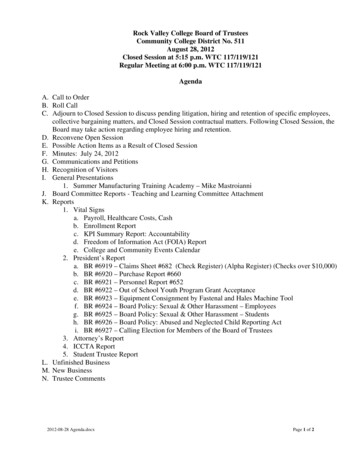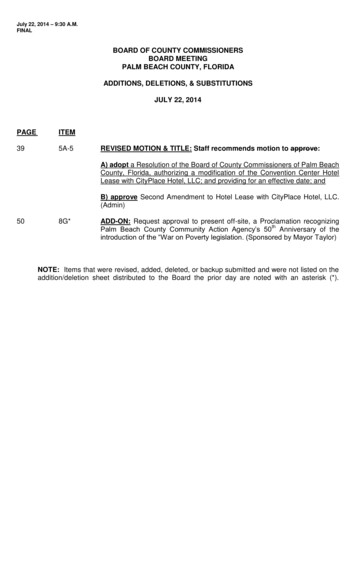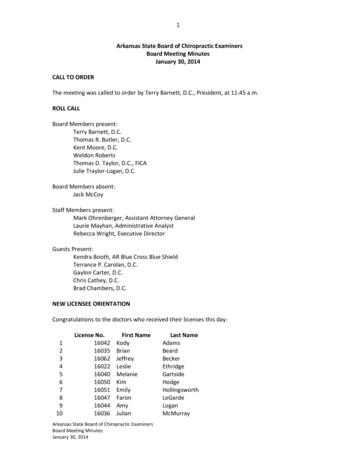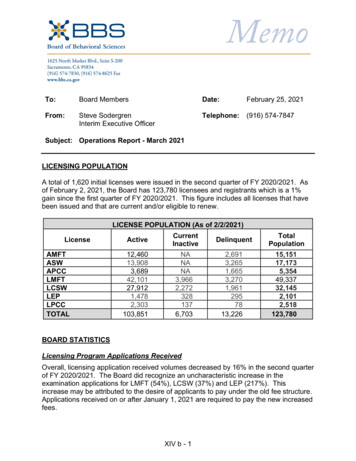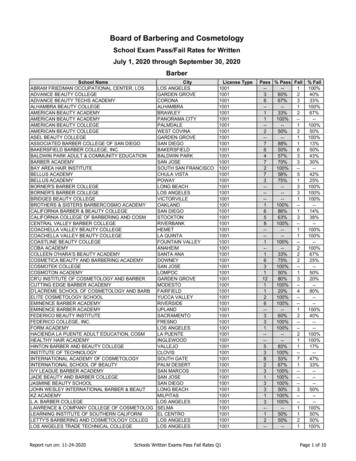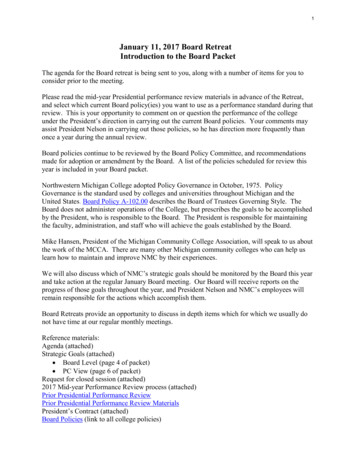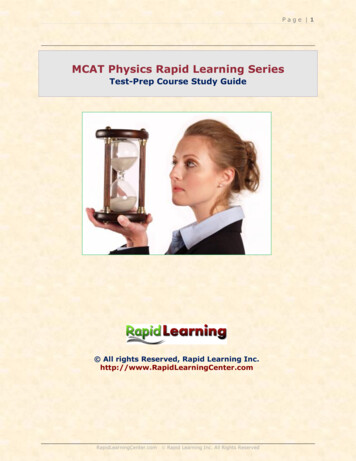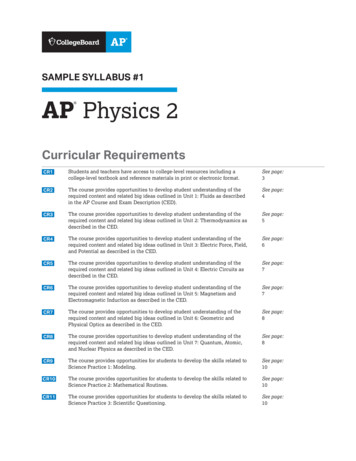
Transcription
SAMPLE SYLLABUS #1AP Physics 2 Curricular RequirementsCR1Students and teachers have access to college-level resources including acollege-level textbook and reference materials in print or electronic format.See page:3CR2The course provides opportunities to develop student understanding of therequired content and related big ideas outlined in Unit 1: Fluids as describedin the AP Course and Exam Description (CED).See page:4CR3The course provides opportunities to develop student understanding of therequired content and related big ideas outlined in Unit 2: Thermodynamics asdescribed in the CED.See page:5CR4The course provides opportunities to develop student understanding of therequired content and related big ideas outlined in Unit 3: Electric Force, Field,and Potential as described in the CED.See page:6CR5The course provides opportunities to develop student understanding of therequired content and related big ideas outlined in Unit 4: Electric Circuits asdescribed in the CED.See page:7CR6The course provides opportunities to develop student understanding of therequired content and related big ideas outlined in Unit 5: Magnetism andElectromagnetic Induction as described in the CED.See page:7CR7The course provides opportunities to develop student understanding of therequired content and related big ideas outlined in Unit 6: Geometric andPhysical Optics as described in the CED.See page:8CR8The course provides opportunities to develop student understanding of therequired content and related big ideas outlined in Unit 7: Quantum, Atomic,and Nuclear Physics as described in the CED.See page:8CR9The course provides opportunities for students to develop the skills related toScience Practice 1: Modeling.See page:10CR10The course provides opportunities for students to develop the skills related toScience Practice 2: Mathematical Routines.See page:10CR11The course provides opportunities for students to develop the skills related toScience Practice 3: Scientific Questioning.See page:10
CR12The course provides opportunities for students to develop the skills related toScience Practice 4: Experimental Methods.See page:11CR13The course provides opportunities for students to develop the skills related toScience Practice 5: Data Analysis.See page:11CR14The course provides opportunities for students to develop the skills related toScience Practice 6: Argumentation.See page:11CR15The course provides opportunities for students to develop the skills related toScience Practice 7: Making Connections.See page:12CR16The course provides students with opportunities to apply their knowledgeof AP Physics concepts to real-world questions or scenarios to help thembecome scientifically literate citizens.See page:12CR17Students spend a minimum of 25 percent of instructional time engagedin a wide range of hands-on laboratory investigations with an emphasison inquiry-based labs to support the learning of required content anddevelopment of science practice skills throughout the course.See page:13CR18The course provides opportunities for students to record evidence of theirscientific investigations in a portfolio of lab reports or a lab notebook (print ordigital format).See page:13
Advanced PlacementPhysics 2 Sample Syllabus #1Textbook Etkina, Eugenia, Gorazd Planinsic, and Alan Van Heuvelen. College Physics. 2nd ed.,AP ed. San Francisco: Pearson, 2019. CR1Teaching Resources Hieggelke, Curtis J, Stephen E Kanim, Thomas L O’Kuma, and David P Maloney.2015. TIPERs: Sensemaking Tasks for Introductory Physics. Boston: Pearson. Hieggelke, Curtis J, Stephen E Kanim, Thomas L. O’Kuma, and David P Maloney.2006. E&M TIPERs: Electricity and Magnetism Tasks. Upper Saddle River, NJ: Pearson. O’Kuma, Thomas L., Curtis Hieggelke, and David P Maloney. 2003. Ranking TaskExercises in Physics. Boston: Pearson/Addison Wesley. Knight, Randall D., Brian Jones, and Stuart Field. 2018. College Physics: A StrategicApproach. 4th ed., AP ed. Boston: Pearson. PIVOT Interactives: High production quality videos of hard to replicate physicalphenomena. Vernier student subscription.CR1The syllabus must cite thetitle, author, and publicationdate of an algebra-based,college-level textbook.Instructional StrategiesThe AP Physics 2 course is conducted using inquiry-based instructional strategies thatfocus on experimentation to develop students’ conceptual understanding of physicsprinciples. The students begin studying a topic by making observations and discoveringpatterns of natural phenomena. The next steps involve developing, testing, and applyingmodels. Throughout the course, the students construct and use multiple representationsof physical processes, solve multistep problems, design investigations, and reflect onknowledge construction through self-assessment rubrics.In most labs, the students use electronic sensor technology in data acquisition.In the classroom, students use graphing calculators and digital devices for interactivesimulations and collaborative activities.Throughout each unit, Topic Questions will be provided to help students check theirunderstanding. The Topic Questions are especially useful for confirming understanding ofdifficult or foundational topics before moving on to new content or skills that build uponprior topics. Topic Questions can be assigned before, during, or after a lesson, and asin-class work or homework. Students will get rationales for each Topic Question that willhelp them understand why an answer is correct or incorrect, and their results will revealmisunderstandings to help them target the content and skills needed for additional practice.At key points within a unit, Personal Progress Checks will be provided in class or ashomework assignments in AP Classroom. Students will get a personal report with feedbackon every topic, skill, and question that they can use to chart their progress, and their resultswill come with rationales that explain every question’s answer. One to two class periods areset aside to re-teach skills based on the results of the Personal Progress Checks.AP-Course Audit Teacher Resources 2020 College Board3
Advanced Placement Physics 2 Sample Syllabus #1COURSE OUTLINE CR2UNITTopicScience PracticesTEXTBOOK CHAPTER(S)UNIT 1. FLUIDS1.1 Fluid Systems1.1, 1.4*, 7.1*1.2 Density4.1, 4.2, 6.4Chapter 13. Static Fluids:density, pressure, buoyancy1.3 Fluids: Pressure and Forces1.1, 1.4, 6.1*, 6.2, 6.4, 7.21.4 Fluids and FreeBody Diagrams1.1, 1.4, 1.5, 2.2, 6.4, 7.2CR2Chapter 14. Fluids in Motion:flow rate, continuity equation,Bernoulli’s equationAssign PPC Unit 1, MCQ Part A1.5 Buoyancy6.1, 6.2Assign PPC Unit 1, MCQ Part B1.6 Conservation of Energyin Fluid Flow2.2, 6.21.7 Conservation of MassFlow Rate in Fluids2.1, 2.2, 7.2Assign PPC Unit 1, MCQ Part CAssign PPC Unit 1, FRQsCR2The syllabus must includethe Unit 1 content listedbelow with the associatedBig Ideas 1, 3, 5, and 7:Systems (SYS), ForceInteractions (INT),Conservation (CON), andProbability (PRO): Pressure and Density Fluid Statics Fluid DynamicsAP-Course Audit Teacher Resources 2020 College Board4
Advanced Placement Physics 2 Sample Syllabus #1UNITTopicScience PracticesTEXTBOOK CHAPTER(S)UNIT 2.THERMODYNAMICS2.1 Thermodynamic Systems1.1*, 1.4*, 7.1*2.2 Pressure, Thermal Equilibrium,and the Ideal Gas Law1.4, 2.2, 3.2, 4.2, 5.1,6.4, 7.1*, 7.2Chapter 12. Gases: Temperature,ideal gas law, speed distribution,kinetic theory2.3 Thermodynamics and Forces1.1*, 1.4, 6.1*, 6.2*,6.4, 7.22.4 Thermodynamics andFree-Body Diagrams1.1, 1.4, 1.5, 2.2, 6.4, 7.2*CR3Chapter 15. First Law ofThermodynamics: internal energy,heating and work, PV diagrams,gas processes, heating mechanismsChapter 16. Second Law ofThermodynamics: irreversibleprocesses, entropyAssign PPC Unit 2, Part A2.5 Thermodynamics andContact Forces6.1*, 6.2*2.6 Heat and Energy Transfer6.42.7 Internal Energy andEnergy Transfer1.1, 1.2, 1.4, 2.1, 2.2,4.2, 5.1, 6.4, 7.2*Assign PPC Unit 2, MCQ Part B2.8 Thermodynamics and ElasticCollisions: Conservationof Momentum2.1*, 2.2, 6.4, 7.2*2.9 Thermodynamics andInelastic Collisions:Conservation of Momentum2.1*, 2.2, 6.4, 7.22.10 Thermal Conductivity4.1*, 4.2, 5.12.11 Probability, ThermalEquilibrium, and Entropy6.2, 7.1Assign PPC Unit 2, MCQ Part CAssign PPC Unit 2, FRQCR3The syllabus must includethe Unit 2 content listedbelow with the associatedBig Ideas 1, 3, 4, and 5:Systems (SYS), ForceInteractions (INT), Change(CHA), and Conservation(CON): First and Second Lawsof Thermodynamics Kinetic Theory Thermal Conductivity Ideal Gas LawAP-Course Audit Teacher Resources 2020 College Board5
Advanced Placement Physics 2 Sample Syllabus #1UNITTopicScience PracticesTEXTBOOK CHAPTER(S)UNIT 3. ELECTRICFORCE, FIELD ANDPOTENTIAL CR43.1 Electric Systems1.1*, 1.4*, 7.1*3.2 Electric Charge6.2, 6.4, 7.23.3 Conservation ofElectric Charge4.1, 4.2*, 5.1, 6.4Chapter 17. Electric Charge,Force, and Energy: electrostaticinteractions, conductors andinsulators, Coulomb’s Law,electric potential energy3.4 Charge Distribution, Friction,Conduction, and Induction1.1, 1.4, 3.2, 4.1, 4.2,5.1, 5.3, 6.4, 7.2Chapter 18. The ElectricField: electric field, electricpotential, capacitorsAssign PPC Unit 3, MCQ Part A3.5 Electric Permittivity3.6 Introduction to Electric Forces1.1, 1.4, 6.1*, 6.2,6.4*, 7.2*3.7 Electric Forces andFree-Body Diagrams1.1, 1.4, 1.5*, 2.2,6.4*, 7.2*3.8 Describing Electric Force2.2, 6.4, 7.2Assign PPC Unit 3, MCQ Part B3.9 Gravitational andElectromagnetic Forces7.13.10 Vector and Scalar Fields3.11 Electric Charges and Fields1.1, 1.4, 2.2, 6.2, 6.4,7.1*, 7.23.12 Isolines and Electric Fields1.4, 2.2, 6.4, 7.2Assign PPC Unit 3, MCQ Part D3.13 Conservation ofElectric Energy1.4, 2.1, 2.2, 6.4, 7.2*Assign PPC Unit 3, MCQ Part CAssign PPC Unit 3, FRQCR4The syllabus must includethe Unit 3 content listedbelow with the associatedBig Ideas 1–5: Systems(SYS), Fields (FLD), ForceInteractions (INT), Change(CHA), and Conservation(CON): Charge and ElectricForce Electric Field Electric Potential Electric PotentialEnergyAP-Course Audit Teacher Resources 2020 College Board6
Advanced Placement Physics 2 Sample Syllabus #1UNITTopicScience PracticesTEXTBOOK CHAPTER(S)UNIT 4. ELECTRICCIRCUITS CR54.1 Definition and Conservationof Electric Charge6.1*, 6.2*, 6.4*, 7.2*4.2 Resistivity and Resistance4.1Chapter 19. DC Circuits:electric current, DC circuits,Ohm’s law, Kirchhoff’s rules,RC circuits, resistivity4.3 Resistance and Capacitance2.2, 4.1, 4.2, 5.1, 6.1, 6.44.4 Kirchhoff’s Loop Rule1.5, 2.1, 2.2, 4.1, 4.2,5.1, 5.3, 6.44.5 Kirchhoff’s Junction Ruleand the Conservationof Electric Charge1.4, 2.2, 6.4, 7.2Assign PPC Unit 4, MCQ Part AAssign PPC Unit 4, MCQ Part BAssign PPC Unit 4, FRQUNIT 5.MAGNETISM ANDELECTROMAGNETICINDUCTION CR65.1 Magnetic Systems1.1, 1.4*, 7.15.2 Magnetic Permeability andMagnetic Dipole MomentChapter 20. Magnetism:magnetic interactions, magneticfield, magnetic forcesChapter 21. ElectromagneticInduction: magnetic flux, Faraday’slaw, Lenz’s law, motional emf5.3 Vector and Scalar Fields5.4 Monopole and Dipole Fields2.2*, 6.4, 7.2*5.5 Magnetic Fields and Forces1.1, 1.2, 1.4, 2.25.6 Magnetic Forces1.4, 4.2, 5.1Assign PPC Unit 5, MCQ Part A5.7 Forces Review1.1, 1.4*, 6.1, 6.2,6.4, 7.2*5.8 Magnetic Flux1.1, 1.4, 2.2*, 6.4Assign PPC Unit 5, MCQ Part BAssign PPC Unit 5, FRQCR5The syllabus must includethe Unit 4 content listedbelow with the associatedBig Ideas 1, 2, 4, and 5:Systems (SYS), Fields(FLD), Change (CHA), andConservation (CON):CR6The syllabus must includethe Unit 5 content listedbelow with the associatedBig Ideas 1–4: Systems(SYS), Fields (FLD), ForceInteractions (INT), andChange (CHA): Ohm’s Law Magnetic Fields Kirchhoff’s Rules Magnetic Forces Complex DC Circuits Faraday’s Law Steady-State RC Lenz’s LawCircuitsAP-Course Audit Teacher Resources 2020 College Board7
Advanced Placement Physics 2 Sample Syllabus #1UNITTopicScience PracticesTEXTBOOK CHAPTER(S)UNIT 6.GEOMETRICAND PHYSICALOPTICS CR76.1 Waves1.2, 5.1, 6.2, 6.4, 7.26.2 Electromagnetic Waves1.1, 6.4, 7.2Chapter 11. Mechanical Waves:mathematical description of a wave,wave interference, superposition6.3 Periodic Waves1.56.4 Refraction, Reflection,and Absorption1.1, 1.4, 4.1, 5.1, 5.2, 5.3,6.4, 7.26.5 Images from Lensesand Mirrors1.4, 2.2, 3.2, 4.1,5.1, 5.2, 5.3Chapter 23. Mirrors andLenses: image formation bymirrors and lenses, mirrorequation, thin lens equationChapter 24. Wave Optics: Young’sdouble slit experiment, diffractiongratings, thin-film interferenceAssign PPC Unit 6, MCQ Part AAssign PPC Unit 6, MCQ Part C6.6 Interference and DiffractionChapter 22. Reflection andRefraction: reflection, refraction,Snell’s law, total internal reflectionChapter 25. ElectromagneticWaves: electromagnetic spectrum,polarization, mathematicaldescription of waves1.4, 6.4, 7.2Assign PPC Unit 6, MCQ Part BAssign PPC Unit 6, FRQUNIT 7. QUANTUM,ATOMIC ANDNUCLEARPHYSICS CR87.1 Systems andFundamental Forces1.1, 7.1, 7.2Chapter 27. Quantum Optics:blackbody radiation, photoelectriceffect, De Broglie wavelength7.2 Radioactive Decay2.1, 2.2, 6.4, 7.27.3 Energy in Modern Physics(Energy in RadioactiveDecay and E mc2)1.2, 1.4, 2.1, 2.2, 6.4, 7.27.4 Mass-Energy Equivalence2.2, 2.3, 6.3, 7.2Chapter 28. Atomic Physics:early atomic models, Bohr’smodel, spectral analysisChapter 29. Nuclear Physics:radioactivity, half-life, nuclearforce and binding energy, nuclearreactions, radioactive decayAssign PPC Unit 7, MCQ Part B7.5 Properties of Wavesand Particles1.4, 6.1, 6.3, 6.4, 7.1, 7.27.6 Photoelectric Effect6.4, 7.17.7 Wave Functions andProbability1.1, 1.2, 1.4, 6.4Assign PPC Unit 7, MCQ Part AAssign PPC Unit 7, MCQ Part CAssign PPC Unit 7, FRQ*Indicates a science practice not assessed with its paired topic on this unit’s Personal Progress CheckCR7The syllabus must includethe Unit 6 content listedbelow with the associatedBig Idea 6: Waves (WAV): Reflection andRefraction Lenses and Mirrors Interference,CR8The syllabus must includethe Unit 7 content with theassociated Big Ideas 1,3, 4, 5, 6, and 7: Systems(SYS), Force Interactions(INT), Change (CHA),Conservation (CON), Waves(WAV), and Probability(PRO).Diffraction, andPolarizationAP-Course Audit Teacher Resources 2020 College Board8
Advanced Placement Physics 2 Sample Syllabus #1Big Ideas In AP Physics 2BIG IDEASUNITSBig Idea 1: Properties.Objects and systems haveproperties such as massand charge. Systems mayhave internal structure.In Unit 3. Electric Charge and Unit 7. Atomic Physicsstudents explore the concepts of fundamental particles withno internal structure such as electrons, and systems builtfrom fundamental particles such as protons and neutrons.Big Idea 2: Fields. Fieldsexisting in space can be usedto explain interactions.In Unit 3. Electric Field and Unit 5. Magnetism studentsconduct experiments to investigate the natureof electric fields and magnetic fieldsBig Idea 3: Force Interactions.The interactions of an objectwith other objects can bedescribed by forces.In Unit 1. Fluids, Unit 3. Electric Force and Unit 5.Magnetism students use free body diagrams to represent thebuoyant force, electric force, and magnetic force that resultfrom interactions between particles or objects of a system.Big Idea 4: Systems.Interactions betweensystems can result inchanges in those systems.In Unit 2. Thermodynamics students learn examples of howthe mechanisms of thermal energy transfer conduction,convection, and radiation work in our everyday lives.Big Idea 5: Conservation.Changes that occur as a resultof interactions are constrainedby conservation laws.The students solve problems in Unit 1. Fluids, Unit 2.Thermodynamics, Unit 5. DC Circuits and Unit 7. QuantumPhysics by applying Bernoulli’s equation, the first law ofthermodynamics, Kirchhoff’s loop rule, and the photoelectriceffect respectively, and realize the universal nature ofconservation of energy across topics.Big Idea 6: Waves. Waves cantransfer energy and momentumfrom one location to anotherwithout the permanenttransfer of mass and serve asa mathematical model for thedescription of other phenomena.In Unit 6. Geometric Optics students investigate applicationsof wave behavior like reflection and refraction throughexperiments in image formation in mirrors and lenses.Big Idea 7: Probability. Themathematics of probabilitycan be used to describe thebehavior of complex systemsand to interpret the behavior ofquantum mechanical systems.In Unit 7. Atomic Physics students conduct research toinvestigate how energy transitions due to emission orabsorption of photons provide the foundation of howlasers work.AP-Course Audit Teacher Resources 2020 College Board9
Advanced Placement Physics 2 Sample Syllabus #1Science PracticesScience Practice 1: Modeling. CR9The student can use representations and models to communicate scientific phenomena andsolve scientific problems.ACTIVITY: Thermodynamic ProcessesThe students consistently use multiple representations to solve physics problems. For example,when analyzing thermodynamic processes, the students model the system as an ideal gas,determine whether any interactions of the environment with the system are relevant, and draw anenergy bar chart to help visualize and apply the first law of thermodynamics. The students use theinformation given to draw a PV (pressure vs. volume) diagram to represent the processes and usethe mathematical model of the first law of thermodynamics to solve for the unknown quantities.Learning Objective 5.B.7.2. Science Practice 1.1‘The student is able to create a plot of pressure versus volume for a thermodynamic process fromgiven data.’Learning Objective 5.B.7.3. Science Practices 1.1, 1.4, and 2.2‘The student is able to use a plot of pressure versus volume for a thermodynamic process to makecalculations of internal energy changes, heat, or work, based on conservation of energyprinciples (i.e., the first law of thermodynamics).’Science Practice 2: Mathematical Routines. CR10The student can use mathematics appropriately.In all the units of study the students engage in problem-solving activities that require theapplication of algebra and trigonometry mathematical routines.ACTIVITY: Electric FieldWhen solving a problem involving the electric field due to multiple electric charges, the studentsfirst sketch an electric field vector diagram to help them determine the x and y-components of theelectric field. Students perform the component vector addition method and use the PythagoreanTheorem to calculate the magnitude of the net electric field.Learning Objective 2.C.4.2. Science Practices 1.4 and 2.2‘The student is able to apply mathematical routines to determine the magnitude and direction of theelectric field at specified points in the vicinity of a small set (2–4) of point charges, and express theresults in terms of magnitude and direction of the field in a visual representation by drawing fieldvectors of appropriate length and direction at the specified points.’Science Practice 3: Scientific Questioning. CR11The student can engage in scientific questioning to extend thinking or to guide investigations withinthe context of the AP Physics 2 course.ACTIVITY: How do we know when to use the wave model or the particle model?DESCRIPTION: The PhET Quantum Wave Interference simulation ference) helps students visualize the behavior of photons, electrons,and atoms as particles and as waves through a double slit.The students work in small groups through a series of ‘experiments’ that confront students withthe basic conflict between the wave model and particle model. The groups have to gatherevidence that will allow them to justify how the double slit interference pattern is consistent withboth the classical wave view and the photon view. After the class discussion, the students shouldbe able to articulate how the wave view is related to the photon view.Science Practice 3.Learning Objective 1.D.1.1‘The student is able to explain why classical mechanics cannot describe all properties of objects byarticulating the reasons that classical mechanics must be refined and an alternative explanationdeveloped when classical particles display wave properties.’Learning Objective 6.G.1.1‘The student is able to make predictions about using the scale of the problem to determine at whatregimes a particle or wave model is more appropriate.’AP-Course Audit Teacher Resources 2020 College BoardCR9The syllabus must includeone assignment, activity, orlab describing how studentsuse representations andmodels to communicatescientific phenomena andsolve scientific problems.The assignment, activity,or lab must be labeled withthe relevant practice(s)(e.g., “1.2”) associated withScience Practice 1.As long as one practiceunder Science Practice 1is represented, evidence issufficient.CR10The syllabus must includeone assignment, activity,or lab describing howstudents use mathematicsappropriately. Theassignment, activity, orlab must be labeled withthe relevant practice(s)associated with SciencePractice 2.As long as one practiceunder Science Practice 2is represented, evidence issufficient.CR11The syllabus mustinclude one assignment,activity, or lab describinghow students engage inscientific questioning toextend thinking or to guideinvestigations within thecontext of the AP course.The assignment, activity,or lab must be labeled withthe relevant practice(s)associated with SciencePractice 3.As long as one practiceunder Science Practice 3is represented, evidence issufficient.10
Advanced Placement Physics 2 Sample Syllabus #1Science Practice 4: Experimental Methods. CR12The student can plan and implement data collection strategies in relation to a particularscientific question.In all units of study students plan and implement procedures to collect data.ACTIVITY: Capacitance investigationDESCRIPTION: Students design a simple capacitor with aluminum foil, a textbook, wires, andcapacitance meter to determine the factors that affect the capacitance of a parallel-plate capacitor.The students plan a data collection strategy to determine the following:Relationship between capacitance and areaRelationship between capacitance and plate separationThe dielectric constant of paperLO 4.E.4.2. Science Practices 4.1 and 4.2‘The student is able to design a plan for the collection of data to determine the effect of changing thegeometry and/or materials on the resistance or capacitance of a circuit element and relate results tothe basic properties of resistors and capacitors.’Science Practice 5: Data Analysis. CR13The student can perform data analysis and evaluation of evidence.In all lab investigations in this course, students are expected to perform analysis of thedata collected.ACTIVITY: Concave MirrorsStudents analyze data to determine the focal length of a concave mirror and determine twolocations where a magnified image can be formed using a concave mirror.LO 6.E.4.1. Science Practices 3.2, 4.1, 5.1, 5.2, 5.3‘The student is able to plan data collection strategies and perform data analysis and evaluation ofevidence about the formation of images due to reflection of light from curved spherical mirrors.’Science Practice 6: Argumentation. CR14The student can work with scientific explanations and theories.In the course, students become familiar with the three components of scientific argumentation:claim, evidence, and reasoning. Students receive explicit instruction in posing meaningfulquestions that include questions of clarification, questions that probe assumptions, andquestions that probe implications and consequences. As a result of the scientific argumentationprocess, students are able to revise their claims and make revisions as appropriate.ACTIVITY: Nuclear Energy: Friend or FoeDESCRIPTION: In addition to the physics concepts, this project requires the evaluation of ethicalconcerns in order to arrive at a decision regarding nuclear energy. This project is meaningfuland engaging to students as it requires the use of evidence-based reasoning through dialogueand provides a context for understanding scientific information.Students work in teams of two to investigate the socioscientific issue about the pros and cons ofthe use of nuclear energy. The research includes an explanation of the process of nuclear fission,the basic operation of a nuclear reactor, how a chain reaction works, and how magnetic andinertial confinements can provide thermonuclear power. Students have to discuss safety, costeffectiveness, and environmental impact including wildlife and human health. The culminationactivity is a debate moderated by the students themselves.Learning Objective 5.G.1.1. Science Practice 6.4‘The student is able to apply conservation of nucleon number and conservation of electric charge tomake predictions about nuclear reactions and decays such as fission, fusion, alpha decay, beta decay,or gamma decay.’AP-Course Audit Teacher Resources 2020 College BoardCR12The syllabus must includeone assignment, activity, orlab describing how studentsplan and implement datacollection strategies inrelation to a particularscientific question. Theassignment, activity, orlab must be labeled withthe relevant practice(s)associated with SciencePractice 4.As long as one practiceunder Science Practice 4is represented, evidence issufficient.CR13The syllabus must includeone assignment, activity, orlab describing how studentsperform data analysis andevaluation of evidence. Theassignment, activity, orlab must be labeled withthe relevant practice(s)associated with SciencePractice 5.As long as one practiceunder Science Practice 5is represented, evidence issufficient.CR14The syllabus must includeone assignment, activity, orlab describing how studentswork with scientificexplanations and theories.The assignment, activity,or lab must be labeled withthe relevant practice(s)associated with SciencePractice 6.As long as one practiceunder Science Practice 6is represented, evidence issufficient.11
Advanced Placement Physics 2 Sample Syllabus #1Science Practice 7: Making Connections. CR15The student is able to connect and relate knowledge across various scales, concepts, andrepresentations in and across domains.ACTIVITY: Laser ApplicationsDESCRIPTION: Students first investigate how a laser works using the PhET Laser lasers). The simulation helps the studentsunderstand how absorption and spontaneous and stimulated emission work.Students will be able to explain how these factors—intensity and wavelength of the lamp, themirror reflectivity, and the lifetimes of the excited states of the atom—influence the laser.After writing their observations they conduct online research to submit a paper that willdemonstrate their ability to read and synthesize scientific literature about the applications oflasers in modern medicine. Common research topics of applications include vision correction(LASIK surgery), tattoo removal, and varicose vein treatments.Learning Objective 5.B.8.1. Science Practices 1.2 and 7.2‘The student is able to describe emission or absorption spectra associated with electronic or nucleartransitions as transitions between allowed energy states of the atom in terms of the principle of energyconservation, including characterization of the frequency of radiation emitted or absorbed.’Real-World ApplicationsCR16Throughout the course the students engage in a variety of activities designed to buildthe students’ reasoning skills and deepen their conceptual understanding of physicsprinciples. Students conduct activities and projects that enable them to connect theconcepts learned in class to real world applications.Activity: Fluid ApplicationsDESCRIPTION: Students write a series of questions that they wonder about related tobuoyancy and density in real-world contexts. In teams of two, the students select oneresearch question. They have two class periods to post their results of the research on aGoogle Doc. Each team presents their information and any sources of data found to theclass. Sample questions are: How do metal ships float? Will a ship full of oil float differently than an empty ship? If an oil tanker develops a leak, why does it sink? How will a ship float in fresh water as opposed to salt water? How do hot air balloons work?CR15The syllabus must includeone assignment, activity,or lab describing howstudents connect andrelate knowledge acrossvarious scales, concepts,and representations inand across domains. Theassignment, activity, orlab must be labeled withthe relevant practice(s)associated with SciencePractice 7.As long as one practiceunder Science Practice 7is represented, evidence issufficient.CR16The syllabus must labeland provide a description ofat least one assignment oractivity requiring studentsto apply their knowledgeof AP Physics conceptsto understand real-worldquestions or scenarios.Would hydrogen balloons float better than balloons filled with hot air?Learning Objective 1.E.1.1‘The student is able to predict the densities, differences in densities, or changes in densitiesunder different conditions for natural phenomena and design an investigation to verify theprediction. [SP 4.2 and 6.4]’Learning Objective 1.E.1.2‘The student is able to select from experimental data the information necessary to determinethe density of an object and/or compare densities of several objects. [SP 4.1 and 6.4]’Learning Objective 3.C.4.2‘The student is able to explain contact forces (tension, friction, normal, buoyant, spring) asarising from interatomic electric forces and that they therefore have certain directions. [SP 6.2]’AP-Course Audit Teacher Resources 2020 College Board12
Advanced Placement Physics 2 Sample Syllabus #1Laboratory InvestigationsCR17The AP Physics 2 course devotes over 25% of the time to laboratory investigations.The laboratory component of the course allows the students to demonstrate the sevenscience practices through a variety of hands-on investigations i
Physics 2 . Curricular Requirements . CR1 . Students and teachers have access to college-level resources including a college-level textbook and reference materials in print or electronic format. See page: 3 . CR2 . The course provi

